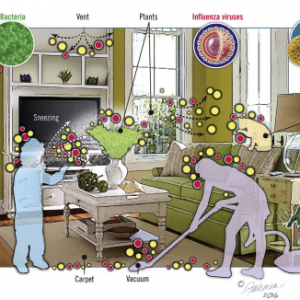Following the last posts about sampling in buildings and other man-made environments, I would like to share the paper I will present at Healthy Buildings 2015 Europe. The paper mainly focuses on sampling advice for practitioners, but we have also tried to explain what the concept of «building microbiome» means to us. Although buildings are not living …
Back in October 2013 I wrote a blog post here called “Building science measurements in the Hospital Microbiome Project: Part 1” where I described the types of building environmental and operational measurements we were making at the time as part of Jack Gilbert’s Sloan-funded Hospital Microbiome Project (Jeff Siegel at the University of Toronto also played a …
When drainage systems fail, a lot of undesirable effects may follow, from leaks that cause mold to fecal-laden water contaminating groundwater and houses. A study from the Heriot Watt University in Edinburgh, Scotland found yet another concern we should have about broken or inadequate building drainage. Airflows in pipes can contain aerosolized pathogens and then escape into …
By Amanda Makowiecki 1st Year Mechanical Engineering PhD Student Miller Research Group, University of Colorado Boulder Researchers at the University of Oregon recently published a paper examining the connection between architectural design and microbial diversity in our buildings (Kembel et al. 2014). Although occupancy type was identified as the strongest predictor of microbial variation, several …
IBM and Mars put out a joint press release today announcing a new effort to use metagenomics to study microorganisms in the food supply chain. The new initiative, called the Sequencing the Food Supply Chain Consortium (SFSC), will use metagenomics and metatranscriptomics to establish what they call a “microbial baseline” that can later be used …
Greetings from the Healthy Buildings Conference Committee! We are excited to be hosting Healthy Buildings 2015 America in Boulder, Colorado, at the University of Colorado Boulder. Healthy Buildings is a unique forum for built environment researchers and professionals to engage with innovative projects, products, and services and to meet and collaborate with colleagues working on …
Whenever I got sick as a young child, my mom insisted upon opening my windows in the mornings to let fresh air in. She claimed it would help me get better if we let clean air in to flush out the dirty air. To me, it was a nuisance. I had the chills and resented …
The environmental engineering research community now recognizes that it is important to understand the bacterial ecology of premise (building) plumbing systems to control opportunistic pathogens (OP). Many investigations, including those supported by the Sloan Foundation MoBE program, have begun to shed light on the factors driving bacterial ecology in drinking water systems. While the bacterial …
This is just a quick post to introduce some early work products resulting from a really exciting project my team has been working on: the Open Source Building Science Sensors (OSBSS) Project (funded by the Sloan Foundation). The goal of OSBSS is to to design and develop a network of inexpensive, open source devices based on …
We are organizing a workshop to catalyze the study of the microbiology of built environments where animals live. The workshop is scheduled for October 7th and 8th at UC Davis. Our aim is to bring together experts in animal health, building science and microbiology to discuss why these systems are worthy of study and how research in this …
